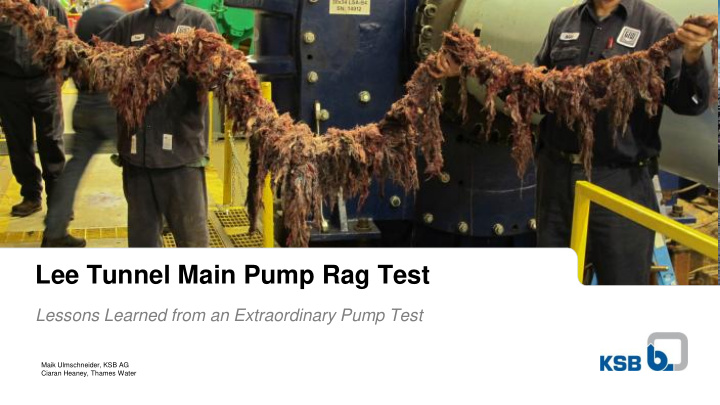



Lee Tunnel Main Pump Rag Test Lessons Learned from an Extraordinary Pump Test Maik Ulmschneider, KSB AG Ciaran Heaney, Thames Water
Lee Tunnel Rag Test Agenda 1) About the Project 2) Rag Test Requirements 3) Test Facility 4) Rag Tests and Findings 5) Conclusion
Lee Tunnel Rag Test About the Project Source: www.waterprojectsonline.com/case_studies/2012/Thames_Lee_Tunnel_2012.pdf
Lee Tunnel Rag Test About the Pump Type: KSB GIW SVP-84 Operating Range: 3,050 l/s @ 87 m 1,950 l/s @ 17 m Weight: 54 t Rated Power: 3.5 MW
Lee Tunnel Rag Test Requirements Material: shredded cotton and polyester, rags and grit Concentration: 2 kg/m³ dry weight rags 400 mg/l grit Rag Dimensions: ≤ 1,000 mm x 75 mm Source: www.riegellinen.com Test Duration: 6 hrs
Lee Tunnel Rag Test Test Facility Location: GIW Hydraulic Laboratory Grovetown, GA, USA
Lee Tunnel Rag Test Test Facility Location: GIW Hydraulic Laboratory Grovetown, GA, USA
Lee Tunnel Rag Test Rag Tests Test 0: Clear water test to create base pump curve under scaled conditions Test 1: Preliminary test to prove test rig and test criteria are fit for purpose Test 2: As Test 1 with altered loading sequence Test 3: Initial rag length 100 mm for test dynamic to be taken into account Test 4: Initial rag length 200 mm for test dynamic to be taken into account Test 5: Initial rag length 1,000 mm with altered loading sequence
Lee Tunnel Rag Test Test 2 Loading Sequence: < 250 mm (1/3 of total) 250 … 500 mm (1/3 of total) 500 … 1,000 mm (1/3 of total)
Lee Tunnel Rag Test Test 2 Findings: - No clogging in first 90 mins. (first set) - Losses 3% on head and 6% on efficiency - Pump clogged during second set
Lee Tunnel Rag Test Test 2 Findings: - No clogging in first 90 mins. (first set) - Losses 3% on head and 6% on efficiency - Pump clogged during second set
Lee Tunnel Rag Test Test 2 Findings: - Firm and tight ropes and clumps were formed, exceeding 1,000 mm length by far. - Ropes mainly consisted of 250 mm rag segments.
Lee Tunnel Rag Test Test 3 Loading Sequence: Full concentration as fast as possible, but with initial length 100 mm
Lee Tunnel Rag Test Test 3 Findings: - No clogging during full test period - Losses on head and efficiency within set limits
Lee Tunnel Rag Test Test 3 Findings: - No clogging during full test period - Losses on head and efficiency within set limits
Lee Tunnel Rag Test Test 3 Findings: - Firm and tight ropes and clumps were formed, mostly within the range of 500…1,000 mm. - Some ropes exceeded length of 1,000 mm by far. - Ropes were mostly formed by fibres. - A significant amount of rag sludge was found in the system.
Lee Tunnel Rag Test Test 3 Findings: - Firm and tight ropes and clumps were formed, mostly within the range of 500…1,000 mm. - Some ropes exceeded length of 1,000 mm by far. - Ropes were mostly formed by fibres. - A significant amount of rag sludge was found in the system.
Lee Tunnel Rag Test Test 4 Loading Sequence: Full concentration as fast as possible, but with initial length 200 mm
Lee Tunnel Rag Test Test 4 Findings: - Pump clogged after approximately 30 mins. after full concentration was loaded.
Lee Tunnel Rag Test Test 4 Findings: - Pump clogged after approximately 30 mins. after full concentration was loaded.
Lee Tunnel Rag Test Test 4 Findings: - Firm and tight ropes and clumps were formed, exceeding 1,000 mm length by far reaching weights up to 80 kg. - Ropes consisted of fibres.
Lee Tunnel Rag Test Test 4 Findings: - Firm and tight ropes and clumps were formed, exceeding 1,000 mm length by far reaching weights up to 80 kg. - Ropes consisted of fibres.
Lee Tunnel Rag Test Conclusion - The Lee Tunnel Main Pump can handle rags up to 1,000 mm x 75 mm. - The dynamic behavior in a closed loop system of conglomeration of ropes that form and ultimately break down must be taken into account. - The strategy of starting with smaller rags that will develop into conglomerations of the required size over time is an effective strategy for addressing this dynamic. - A ratio in the range of 1:10 (initial to final size) proved effective in the present test set up.
Recommend
More recommend